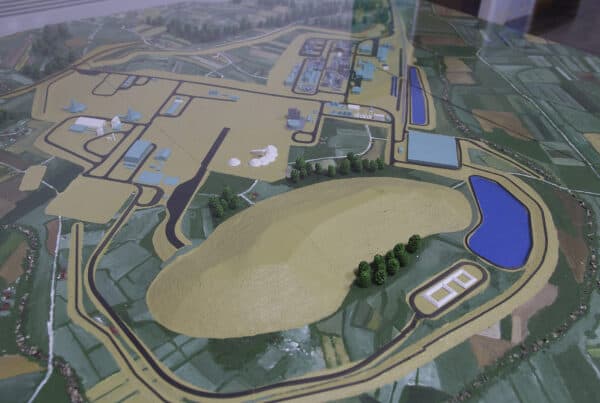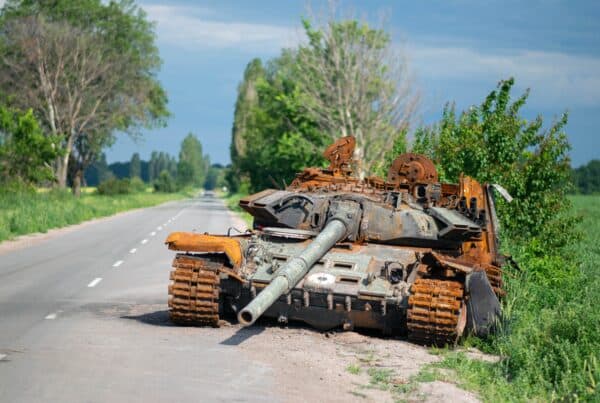Ukraine’s modern demography is ultimately shaped by war
World War II had a profound impact on the age pyramid of Ukraine, as well as the ratio of females to males in the population, as we can see in this graph below. The war resulted in a significant loss of life, particularly among young men, which had long-lasting effects on the demographics of the country.
According to estimates, Ukraine lost around 8 million people during World War II, including both military and civilian casualties. This loss of life had a significant impact on the age structure of the population, particularly among men. In the post-war period, there was a significant shortage of men of reproductive age, which led to a decline in the number of births.
As a result of the loss of men during the war, there was also a significant shift in the male-female ratio in the population. Before the war, there were slightly more women than men in Ukraine, with a sex ratio of around 106 men per 100 women. However, during and after the war, the male-female ratio shifted dramatically, with many more women than men in the population, which can still be seen today.
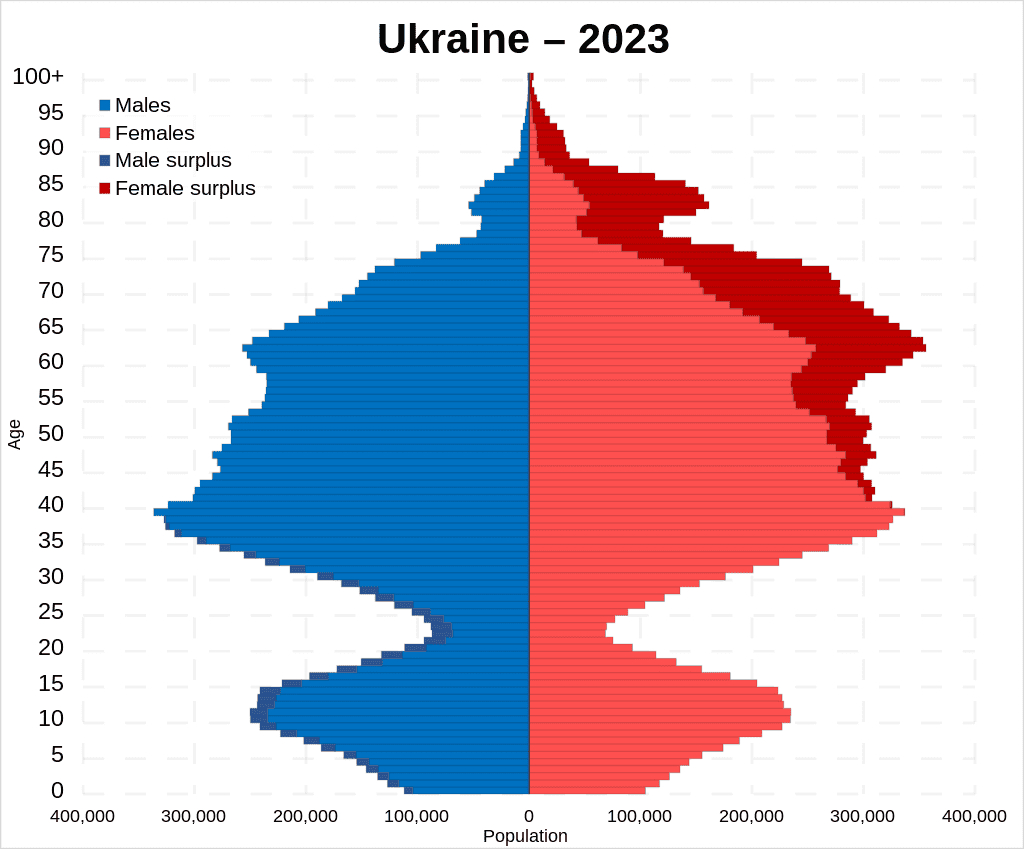
According to estimates, in 1950, there were around 76 men for every 100 women in Ukraine. This shift in the sex ratio was due to a combination of factors, including the loss of men during the war, as well as post-war migration patterns, which often involved more men than women leaving the country.
The impact of World War II on the age pyramid and sex ratio of Ukraine has had long-lasting effects on the demographics of the country. Today, Ukraine has one of the oldest populations in Europe, with a median age of around 42 years. The country also has a relatively low fertility rate, which is partly a result of the loss of men during the war, as well as changing social and economic factors.
World War II had a significant impact on the demographics of Ukraine, with a loss of life resulting in a significant shift in the age structure and sex ratio of the population. While the country has since undergone significant changes, including shifts in fertility rates and migration patterns, the legacy of the war continues to be felt in the demographics of the country today.
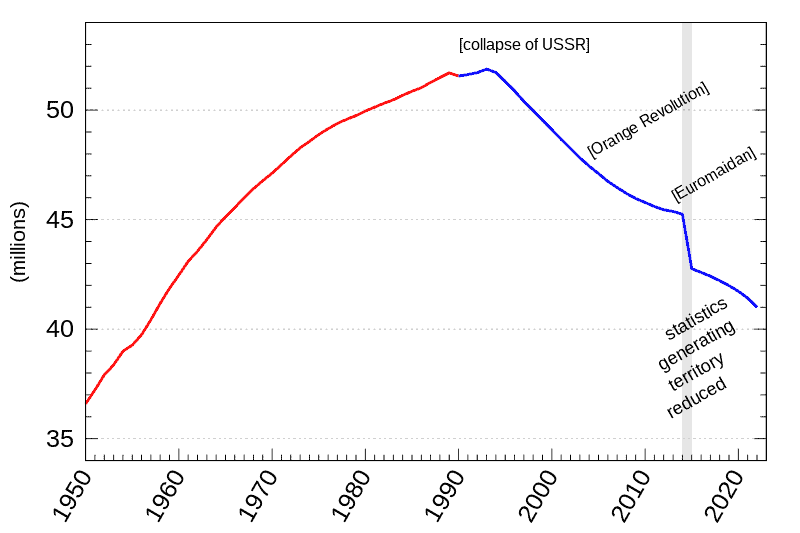
Since the fall of the Soviet Union in 1991, Ukraine has undergone significant demographic changes, including shifts in population size, age structure, and fertility rates.
In the years following independence, Ukraine experienced a significant decline in population size. According to estimates, the population of Ukraine declined from around 52 million in 1991 to around 41 million in 2020. This decline was due to a combination of factors, including low fertility rates, emigration, and higher mortality rates.
The collapse of the fertility rate
In addition to changes in population size, Ukraine has also undergone significant shifts in its age structure. Like many other countries, Ukraine has experienced a significant increase in the proportion of older adults in its population. In 1991, around 9% of the population was over the age of 65. By 2020, this proportion had increased to around 16%. This shift towards an older population has been driven by a combination of factors, including declining fertility rates and increasing life expectancy.
One of the most significant demographic changes in Ukraine since the fall of the Soviet Union has been the decline in fertility rates. In the years following independence, the fertility rate in Ukraine declined rapidly, from around 2.3 children per woman in the early 1990s to a low of 1.2 children per woman in the mid-2000s.
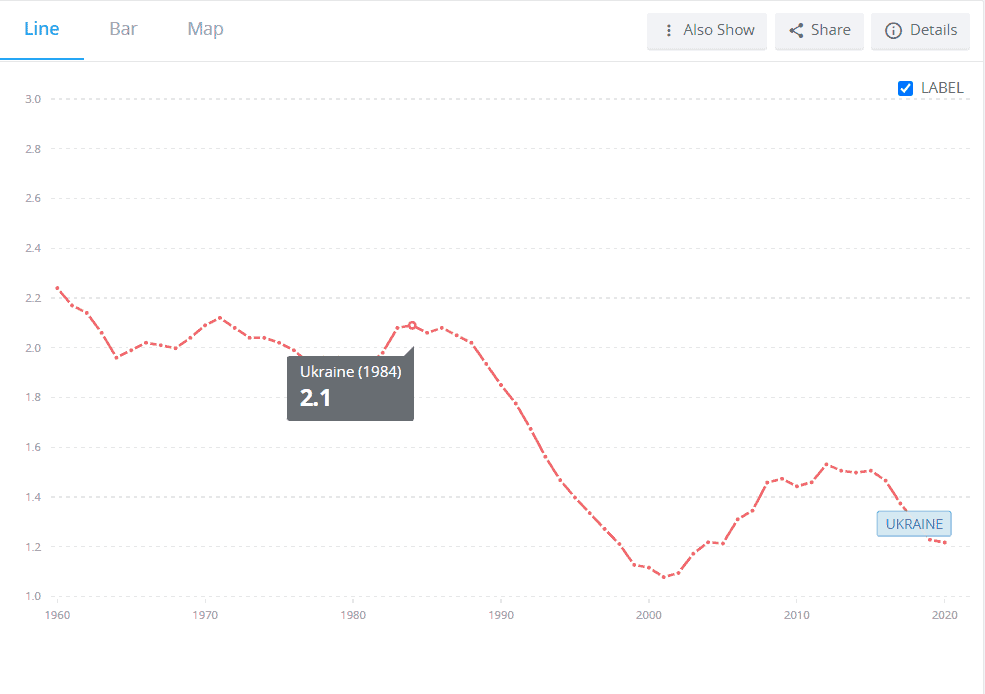
Source: https://data.worldbank.org/indicator/SP.DYN.TFRT.IN?locations=UA
The reasons for this decline in fertility rates are complex and varied. One factor has been changing social attitudes towards family size and childbearing. Many young people in Ukraine today are delaying marriage and childbearing, or choosing not to have children at all.
In addition to changing social attitudes, economic factors have also played a role in the decline in fertility rates. The economic instability that followed independence led to high levels of unemployment and poverty, which made it difficult for many families to afford to have children. While the economic situation in Ukraine has improved in recent years, many families still face significant financial challenges that may deter them from having children.
As of 2022, the Russian invasion of Ukraine has had a significant demographic impact on the country, as well as on the wider region. The conflict has resulted in the displacement of millions of people, including a large number of refugees who have fled to Europe. These demographic changes are likely to have long-lasting effects on Ukraine and its neighbours.
Displacement of People
The Russian invasion of Ukraine has resulted in the displacement of millions of people, both within Ukraine and across its borders. According to the United Nations, as of February 2022, over 7 million people in Ukraine were in need of humanitarian assistance due to the conflict. Of these, around 1.7 million were internally displaced persons (IDPs) within Ukraine, while around 1.3 million had fled to neighbouring countries, including Poland, Romania, and Hungary.

The number of refugees who have fled to Europe is particularly significant, as many of these individuals may not return to Ukraine even if the conflict ends. The reasons for this are complex and varied, but include concerns about safety and security, as well as difficulties in accessing basic services such as healthcare and education. Many refugees may also choose to remain in Europe due to the opportunities for employment and economic stability that are not available in Ukraine.
The displacement of millions of people has had a significant impact on the demographics of Ukraine, as well as on the wider region. In addition to the loss of life resulting from the conflict, the displacement of people has disrupted social networks and led to a breakdown in community structures. This can have long-lasting effects on the mental health and well-being of individuals and communities affected by the conflict.
The impact of the conflict on demographics is likely to be particularly significant in the long term, as many of those who have fled to Europe may not return to Ukraine. This could lead to a brain drain, as those with skills and education choose to remain in Europe rather than returning to their home country. This could have significant implications for the future development of Ukraine, as well as for the wider region.
The Russian invasion of Ukraine in 2022 has had a significant demographic impact on the country, as well as on the wider region. The displacement of millions of people, including a large number of refugees who have fled to Europe, is likely to have long-lasting effects on Ukraine and its neighbours.
The displacement of Ukrainian refugees as a result of the Russian invasion has had significant demographic consequences, particularly in regards to an aging population and pensioners. Many of those who have fled to other countries may not return to Ukraine, which could exacerbate existing demographic challenges and have long-lasting effects on the country’s population structure.
Aging Population and Pensioners
Ukraine is already facing demographic challenges due to an aging population and declining birth rates. The number of people aged 60 and above is expected to increase from around 20% of the population in 2017 to around 30% by 2050. At the same time, the working-age population is expected to decline, which could put pressure on the pension system and other social services.
The displacement of Ukrainian refugees who may not return home could exacerbate these existing demographic challenges. Many of those who have fled the conflict are of working age, which could further reduce the number of people available to work and contribute to the pension system. At the same time, many of those who remain in Ukraine are likely to be older and in need of care and support, which could place additional strain on social services.
The long-term effects of the displacement of Ukrainian refugees who may not return home are difficult to predict, but are likely to be significant. In addition to the demographic challenges outlined above, there may be economic and social consequences, as well. Those who have fled to other countries are likely to be highly educated and skilled, which could lead to a brain drain and impact future economic development in Ukraine. The loss of social networks and community structures could also have long-term implications for the well-being and mental health of those affected by the conflict.
Addressing the demographic challenges created by the displacement of Ukrainian refugees who may not return home will require a coordinated policy response. This could include efforts to attract and retain highly skilled workers and to support the pension system and other social services. There may also be opportunities to leverage the skills and expertise of Ukrainian refugees who have settled in other countries, for example through initiatives to promote entrepreneurship and economic development.
The displacement of Ukrainian refugees as a result of the Russian invasion has had significant demographic consequences (so far), particularly in regards to an aging population and pensioners. The loss of skilled workers and contributors to the pension system could have long-lasting effects on the country’s population structure and economic development. Addressing these challenges will require a coordinated policy response that takes into account the needs and experiences of those affected by the conflict.
The consequences of the current loss of young men into the conflict
The loss of Ukrainian soldiers as a result of conflict and military operations can have significant demographic consequences, particularly in regards to the fertility rate of Ukraine in the future. The loss of young men in particular can have an impact on the number of children born and the overall population growth of the country.
The fertility rate is a key indicator of the potential for population growth in a country. In Ukraine, the fertility rate has been declining in recent years and is currently estimated at around 1.4 children per woman, which is well below the replacement level of 2.1 children per woman. The loss of Ukrainian soldiers can have an impact on the fertility rate in a number of ways.
As we have already seen, with World War II, the loss of young men who are of reproductive age can reduce the number of potential fathers in the population. This can have a direct impact on the number of children born and can contribute to a decline in the fertility rate over time. Additionally, the loss of soldiers can also have an indirect impact on the fertility rate, as it can lead to social and economic disruption that can make it more difficult for families to have children.
The long-term effects of the loss of Ukrainian soldiers on the fertility rate are still very difficult to predict, but are likely to be significant. If the decline in the fertility rate continues, it could have implications for the country’s population structure, economy, and social welfare system. For example, a decline in the working-age population could put pressure on the pension system and other social services.
Moreover, the loss of soldiers can also have an impact on gender ratios in the population. If a significant number of soldiers lost are male, this could lead to a skewed sex ratio in the population. This could have implications for marriage and family formation patterns, as well as for social stability and cohesion, condemning even more the demographic prospects for Ukraine.
What if Ukrainian refugees don’t return home?
The conflict in Ukraine and the subsequent displacement of individuals has led to a significant number of refugees leaving the country. The question of whether these refugees will return to Ukraine or remain settled in other countries has important implications for Ukraine’s population size and growth.
Since the start of the conflict in Ukraine, more than 1.7 million people have been displaced within the country, and an estimated 1.4 million have fled to neighbouring countries and Europe. While many of these individuals may eventually return to their homes, there is a significant risk that some may remain displaced permanently due to political, economic, and social factors.
The current population of Ukraine was estimated to be around 42 million people. If Ukrainian refugees do not return, the population could decline over time. The extent of this decline would depend on a number of factors, including the number of refugees who do not return and the fertility rate of the remaining population.
According to a report by the United Nations Population Division, the projected population of Ukraine in 2050 under a medium variant scenario is around 38 million people. This estimate assumes that the country’s fertility rate will continue to decline, and that the number of deaths will exceed the number of births over time. If the decline in population caused by the loss of refugees is not offset by increases in the fertility rate or immigration, this estimate could be even lower.
However, other estimates suggest that the population decline could be even more significant. For example, a report by the Ukrainian Institute for the Future estimated that if all Ukrainian refugees settled permanently in other countries and did not return to Ukraine, the population could decline to as low as 30 million people by 2050. This estimate takes into account the impact of both the loss of refugees and the country’s declining fertility rate.
To address the demographic challenges created by the loss of Ukrainian refugees, the government of Ukraine could consider implementing policies aimed at encouraging population growth. For example, policies aimed at increasing the fertility rate, such as financial incentives for having children and support for working parents, could help to offset the decline in population caused by the loss of refugees.
These policies could be complemented by efforts to improve social and economic conditions in the country, including investments in education and infrastructure with its partners from the European Union.
Conclusion
In conclusion, the estimated population of Ukraine if Ukrainian refugees do not return is a complex and multifaceted issue. While population estimates vary depending on a number of factors, there is a general consensus that the loss of refugees could lead to a decline in the country’s population over time. To address these challenges, the government of Ukraine could consider implementing policies aimed at encouraging population growth and increasing immigration. By taking a proactive approach to addressing the demographic challenges created by the loss of refugees, Ukraine can help to ensure that its population remains healthy and vibrant for years to come.
Addressing the demographic challenges created by the loss of Ukrainian soldiers will require a coordinated policy response. This could include efforts to support the families of soldiers who have been lost, including financial assistance and social services. There may also be opportunities to promote policies that support families and encourage higher fertility rates, such as family-friendly policies and incentives for having children.
One possible policy response is to increase financial support for families with children. This could include providing subsidies for childcare, reducing the cost of education, and increasing tax credits for families with children. Additionally, policies aimed at supporting work-life balance, such as flexible working arrangements and parental leave, could also help to encourage higher fertility rates.
Another potential policy response is to invest in education and training programs to help young people acquire the skills and knowledge needed to compete in the labour market. This could help to ensure that the working-age population is able to support the needs of the growing elderly population, particularly in terms of social services and healthcare.
The loss of Ukrainian soldiers as a result of conflict and military operations can have significant demographic consequences, particularly in regards to the fertility rate of Ukraine in the future. The loss of young men in particular can have an impact on the number of children born and the overall population growth of the country. Addressing these challenges will require a coordinated policy response that takes into account the needs and experiences of those affected by the conflict. By promoting policies that support families and encourage higher fertility rates, Ukraine can help to ensure that its population remains healthy and vibrant for years to come.
Ukraine has a history and experience in recovering from population loss, especially after war, as we have seen already. However, as we have witnessed too, wars have their tolls on demographics. In order for Ukraine to recover from this latest conflict, it needs to have a coordinated effort with countries receiving its refugees, as well as family friendly policies in order for its population to bounce back and acquire the desire social and economic stability for post-war rebuilding.
Bibliography
1. Demographics of Ukraine since World War II:
- United Nations, Department of Economic and Social Affairs, Population Division. (2019). World Population Prospects 2019, Volume II: Demographic Profiles. https://population.un.org/wpp/Publications/Files/WPP2019_Volume-II-Demographic-Profiles.pdf
- Ukrainian Institute of National Memory. (2016). Ukrainian Losses in the Second World War. https://memory.gov.ua/en/second-world-war/ukrainian-losses-in-the-second-world-war/
- The World Bank. (2021). Ukraine Overview. https://www.worldbank.org/en/country/ukraine/overview
2. Demography and fertility rate of Ukraine from the fall of the Soviet Union until 2020:
- United Nations, Department of Economic and Social Affairs, Population Division. (2019). World Population Prospects 2019, Volume II: Demographic Profiles. https://population.un.org/wpp/Publications/Files/WPP2019_Volume-II-Demographic-Profiles.pdf
- The World Bank. (2021). Ukraine Overview. https://www.worldbank.org/en/country/ukraine/overview
- National Academy of Sciences of Ukraine. (2020). Demographic situation in Ukraine: Results of 2019. https://ukrstat.org/en/stat-publications-datenbanken-en/1354/1424/8584
3. Demographic impact of the Russian invasion of Ukraine in 2022:
- United Nations, Department of Economic and Social Affairs, Population Division. (2019). World Population Prospects 2019, Volume II: Demographic Profiles. https://population.un.org/wpp/Publications/Files/WPP2019_Volume-II-Demographic-Profiles.pdf
- Office of the United Nations High Commissioner for Human Rights. (2022). Human Rights Report on Ukraine 16 February – 15 May 2022. https://www.ohchr.org/EN/Countries/ENACARegion/Pages/UAIndex.aspx
- BBC News. (2022). Russia-Ukraine war: The human cost so far. https://www.bbc.com/news/world-europe-60467185
4. Demographic consequences of Ukrainian refugees not returning home:
- United Nations, Department of Economic and Social Affairs, Population Division. (2019). World Population Prospects 2019, Volume II: Demographic Profiles. https://population.un.org/wpp/Publications/Files/WPP2019_Volume-II-Demographic-Profiles.pdf
- International Organization for Migration. (2021). Ukraine: Displacement Overview. https://www.iom.int/countries/ukraine/displacement-overview
- The World Bank. (2021). Ukraine Overview. https://www.worldbank.org/en/country/ukraine/overview
5. Demographic consequences of the loss of Ukrainian soldiers in regards to the fertility rate of Ukraine in the future:
- United Nations, Department of Economic and Social Affairs, Population Division. (2019). World Population Prospects 2019, Volume II: Demographic Profiles. https://population.un.org/wpp/Publications/Files/WPP2019_Volume-II-Demographic-Profiles.pdf
- National Academy of Sciences of Ukraine. (2020). Demographic situation in Ukraine: Results of 2019. https://ukrstat.org/en/stat-publications-datenbanken-en/1354/1424/8584
- Ukrainian Institute for the Future. (2019). Future of Ukraine: Population Trends and National Security. https://uifuture.org/en/publications/f




